(SPOT.ph) You know how you have childhood favorites that you think everyone just knows about—but then you inevitably grow up only to find out it was specific to your circle and the rest of the world just doesn’t know about it? It’s almost offensive, honestly. That’s ngohiong for Cebuanos. And before you go asking if it’s lumpia, it’s not. Insisting that it is is a sure way to get on a Cebuano’s nerves. It would be like saying turon is a dessert spring roll. Yes, it might be factually accurate, but it completely misses the mark; It just doesn’t capture the essence and nuances of the dish. So in celebration of one of Cebu’s best open secrets—and because we feel bad for the rest of you folks out there—we took it upon ourselves to spread the word and point you towards the best versions you can get when in the area.
Also read: Smackdown: Who Has the Best Steamed Fried Rice in Cebu?
So, What Is Ngohiong?
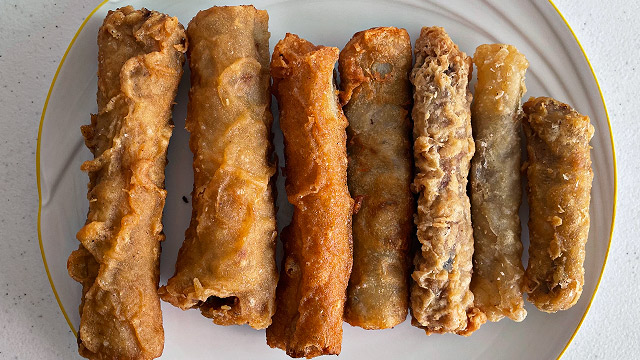
Ngohiong (pronounced ngo-yong) is a—and it pains us to call it this, but for the sake of a common reference—a deep-fried lumpia that’s filled with crunchy ubod (particularly coconut heart of palm), spring onions, and other veggies. This mixture is coated with a thick starchy batter to make it extra crispy. It gets its name from the main flavor, the Hokkien term for “five spice,” and yes, there are other goh hiong keng (literally a five-spice roll) out there. The most popular of which is kikiam, which is also called ngoh hiang in Singapore but lor bak in Malaysia. Cebu ngohiong obviously took a different path; it doesn’t even use tofu skin. But there are theories that Cebu’s ngohiong is an offshoot of that culinary tradition. Since it’s not documented, the origin story is pretty hazy. It’s almost an urban legend in its own right. The best we can do is say it probably came from the Downtown area, as it was once the center of commerce.
The standard dips are a soy sauce-vinegar mix and a tangy homemade chili sauce. The latter comes in varying degrees of lumpiness depending on how well the vendor's choice of starch can hold the colloid. Both sauces add to the flavor of the ngohiong, but more importantly they cut through the grease so you can keep going back for more without things getting bidli (cloying).
If you’re going full-on, have it with puso, fried manok Bisaya (native chicken), and atay and batico’n (liver and gizzard, occasionally served together and held together by a toothpick) as well. They’re all coated with the same batter and fried in the same oil with the ngohiong, but they each have their own distinct natural flavors—and of course, textural differences! So it never feels like you’re eating the same thing.
This is typically eaten for lunch as it used to be that eateries would make them fresh in the morning. Once they were sold out, you would have to wait for the next day. Back when in-person classes were a thing, some of these eateries were strategically located near schools, so generations of Cebuanos grew up on this street food as an after-school treat. Now, ngohiong is available frozen or half-cooked so you can have it any time at home.
The Rankings: From So-So to the Platonic Ideal
Hukad sa Golden Cowrie
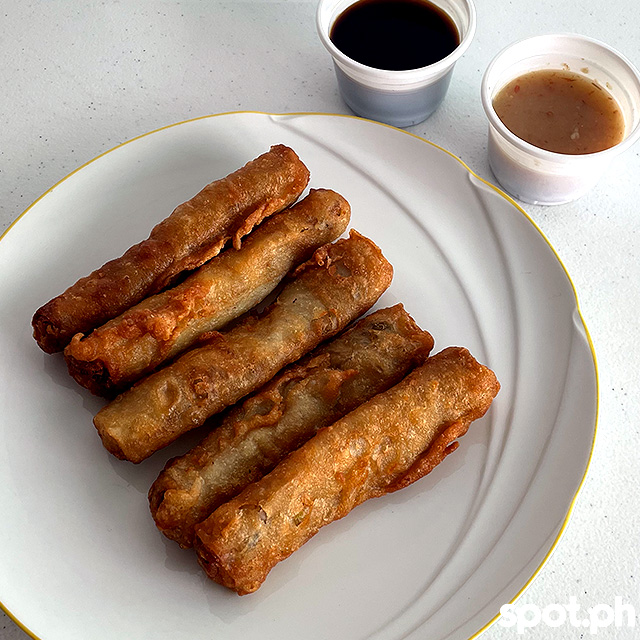
Hukad is probably the most instantly recognizable name on this list, just because it’s become a restaurant franchise that has reached other parts of the country. It’s also the only proper restaurant on the list, so it's easily the most accessible for tourists. This also means it’s the priciest of the entire list—we’re talking P150 for five pieces at around 13 centimeters each. However, their ngohiong is a more creative take on the Cebuano dish, which is as politely as we can say that their version skews closer to lumpia than actual ngohiong.
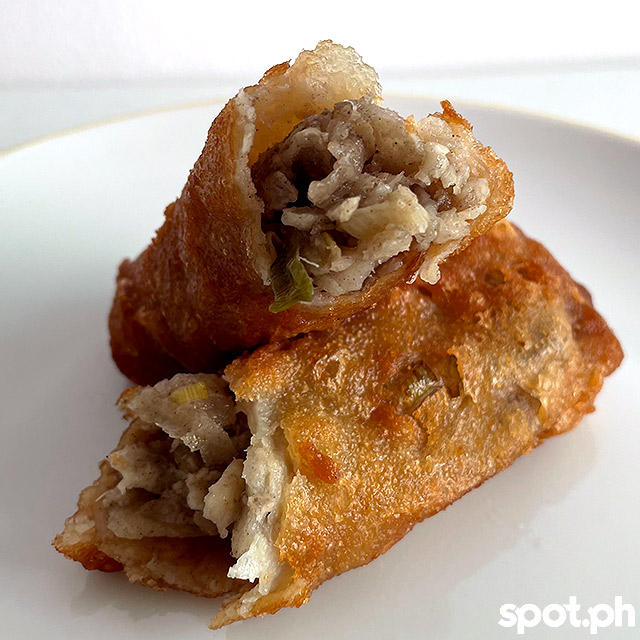
The ngohiong does have the signature five spice, but it’s overpowered by a strong onion and anise flavor that makes it floral and peppery. The onions especially are not standard. Maybe this is some kind of concession they’ve had to make to make it more palatable for the rest of the nation; maybe it’s their way of putting their own stamp on the dish; who knows? The filling is oddly damp, taking away from the enjoyable nuances of texture of the ngohiong. The skin itself looks more like fried lumpia wrapper; it barely has any batter that's characteristic of classic ngohiong. The spicy sauce is lumpy and doesn't impart much flavor, only a mild heat.
Report card: A+ for accessibility, availability, and representation, but C for the actual ngohiong experience. We had to dock points for the reinterpretation. Why fix it if it ain’t broke?
Chinese Ngohiong
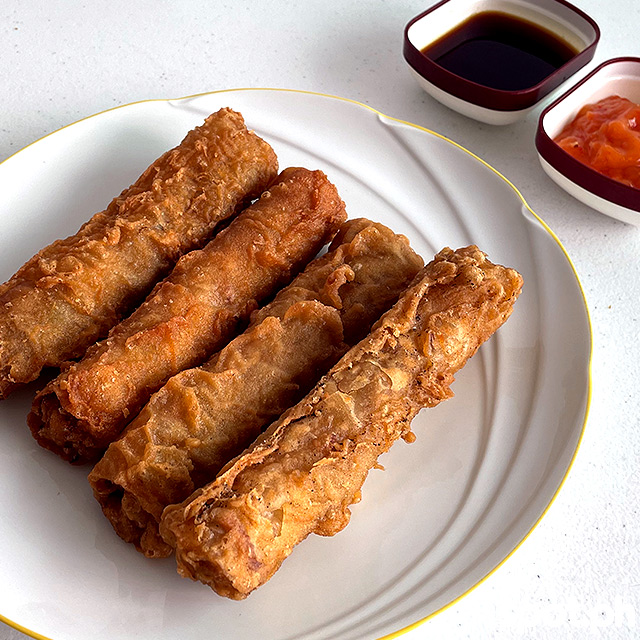
Chinese Ngohiong positioned itself near lots of schools—University of San Carlos, Philippine Christian Gospel School, Cebu Normal University to name a few. If that’s not enough to ensure a loyal following by influencing young taste buds, we don’t know what is. Chinese Ngohiong sells theirs at P11 a piece and is the largest on the list at 14 centimeters.
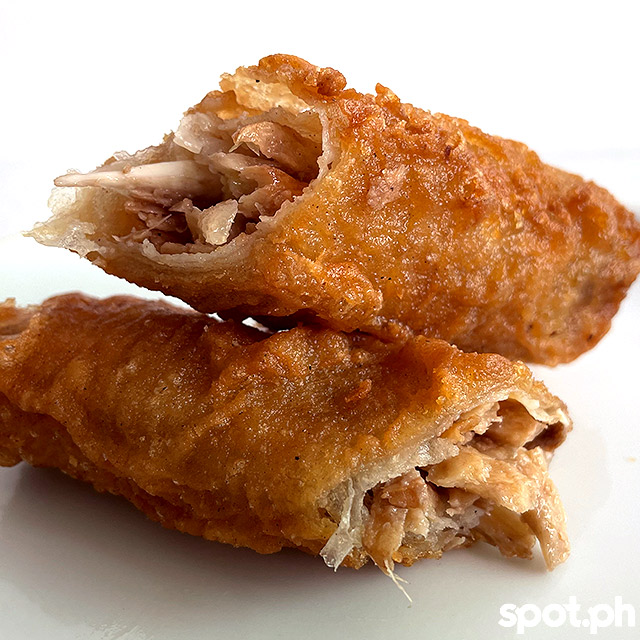
Chinese Ngohiong is the mildest of the bunch in aroma, taste, and texture. In fact, there’s really not much to say about it because of how bland it is. The filling is a bit mushy and their addition of flour makes for an even softer mouthfeel. Flavor-wise, the five spice is virtually imperceptible. The only flavor we could detect is that of spring onions, but even then we wouldn’t call it dominant. To compensate, its soy sauce dip is extra salty (with hardly any vinegar), but the dip and the ngohiong don’t come together in a way that’s complimentary. Instead, it just feels like too much salt. The chili sauce doesn’t add much flavor either. It’s lumpy and starchy, and even then you can only get the smell of chilis. Even the heat is mild.
Yes, the size is impressive, but not so much when it’s compared to the other vendors who sell their ngohiong at the same price. They happen to be siblings who are all in the same business. They’ll happily refer customers to each other, but they’ll also cheekily tell you their mixes are “mao-mao ra, pero di gyud ingon nga parehas” (similar but not exactly the same).
Report card: A+ for size and nostalgia, that’s about it.
Ho Ngohiong
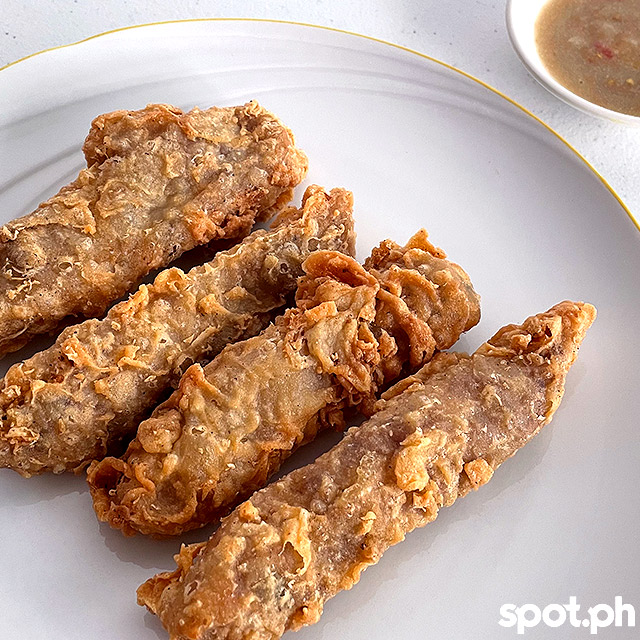
You might remember how Ho Ngohiong made waves on local news in 2017 when they opened a food truck. It’s a homegrown chain that makes affordable ngohiong (P8/piece, at around 12 centimeters), so it’ll be easy to find. Sadly, the ngohiong we got from them was inconsistent in taste. Some were so strongly flavored with anise and cloves that it overpowered the other spices and gave the ngohiong a mildly bitter taste. On the pieces we tried wherein the five spices were in balanced proportions, the ngohiong was pretty standard. In any case, what does set Ho apart is how much batter is on their ngohiong. Just by looking at it, you can already tell it’s crunchy. This sometimes worked against it as it was too thick and made the ngohiong hard to eat—literally gahi (hard). It’s not so bad that it actually hurt our gums, but it was a nuisance, especially for those whose jaws easily get tired or those who have more sensitive palates.

As for the sauce, it didn’t look appetizing; it looked grainy and non-homogenous. But opening the packet gave off a piquant aroma that was more promising than it looked. As we gave it a taste, it turned out to be tangy and fragrant, and it didn't have the split mouthfeel we anticipated from its appearance. So that really helped.
Report card: A for availability, another A for how densely filled it is, and A+ for having a food truck (but who knows if those still go driving around), but D for inconsistency. This really had potential though.
Edd’s Ngohiong

Edd’s Ngohiong (P11/piece) surprised us by the addition of a third sauce. The “sweet sauce” has a fruity-floral fragrance to it that reminds us of processed mango nectar. The intensity of its yellow-orange hue is also a dead giveaway of its unnatural colorants, we think. This use of fruit juice is also carried over in its spicy sauce, though it is harder to identify because of how strong the chili is. The sweet and floral fragrance enhances the chili’s own flavors and compliments the sourness of the sauce. Overall, it really helps complete the ngohiong experience. The soy-vinegar dip is a good balance of salty and sour, too.
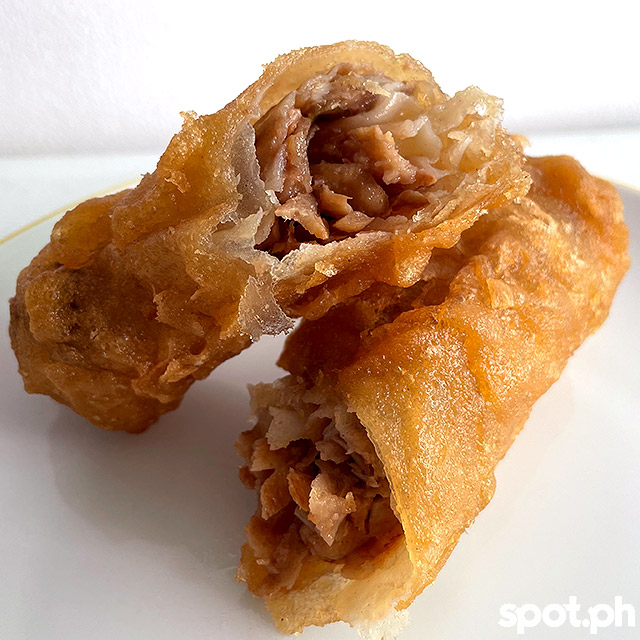
The ngohiong itself is large—13 centimeters long and around three centimeters in diameter—and filling. It’s quite similar to Chinese Ngohiong, but Edd’s has more flavor, more textural fillings, and even more flour inside. The filling is reasonably seasoned and has a hint of sweetness to it. It also had a very slightly vegetal taste to it. Flavor-wise, the spring onion as well as the five spice are detectable.
Report card: A+ for innovation (no one said they had to go and make a third sauce!) and maybe A for size too (it’s very filling!), C+ for everything else.
Ann's Ngohiong by Doming’s
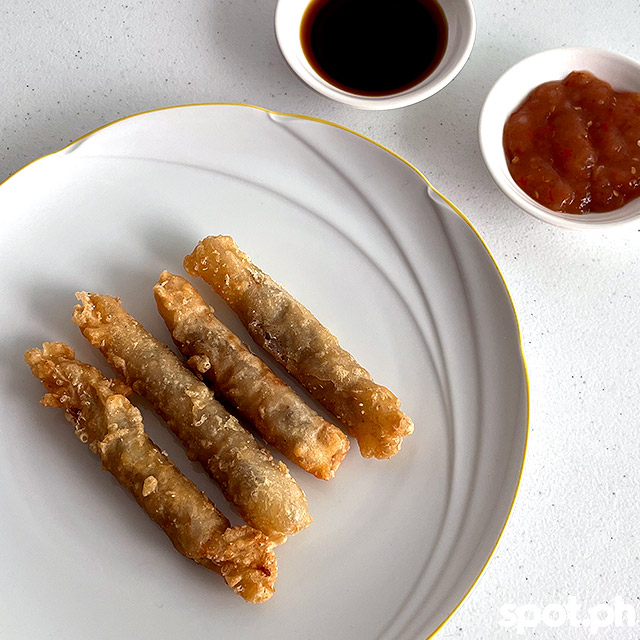
We’d like to draw a divide from this point of the list. From here onwards, five spice is actually noticeable, and that makes the ngohiong more fragrant…like actual ngohiong.
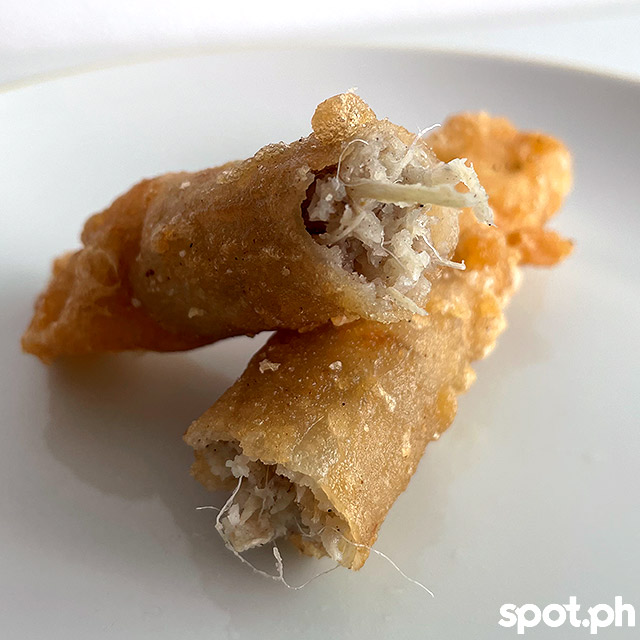
Despite Doming’s reputation as the original, it’s still the cheapest at P7 a piece, or P6 if you’re buying wholesale. It ‘s the thinnest on the list at only a centimeter in diameter, but is of average length at 12 centimeters. Now we’ve always loved Doming’s, but the ubod they use is visibly stringy. We can’t even put into words how very bothersome these “hairs” are. Another thing that stood out was that it was the saltiest of the bunch. It’s just too salty to eat on its own. This ngohiong needs puso to balance it out.
Other than that, it’s hard to fault the OG. The thickness of the wrapper is pretty consistent—and consistency is hard to come by with street food!—so the bite and the crunch come out pretty much the same every mouthful.
The spicy sauce was disappointingly bland—no salt or vinegar. Just chilis and starch. But that can be excused because we’re sure they know you’re going to be reaching for that soy dip anyway. Mix them all together, and you’re good to go. Just make sure you have rice ready. We’re still salty about that ngohiong.
Report card: A for extended operating hours (PSA: They’re now open until 5 p.m., people! They used to close around 2.). But they’re middling at B for the actual ngohiong because of the annoyingly fibrous ubod. Other than that, we would have scored this higher.
TJRB’s Ngohiong Place

The owner of TJRB is also related to the owners of Edd’s and Chinese Ngohiong, but it’s the most low key among the three. Some don’t even know its name, just that it’s the one across the old Sacred Heart School for Boys campus. Or if you’re a clueless alumnus, it’s the one beside Filbar’s. Even the pork barbecue is nostalgic.
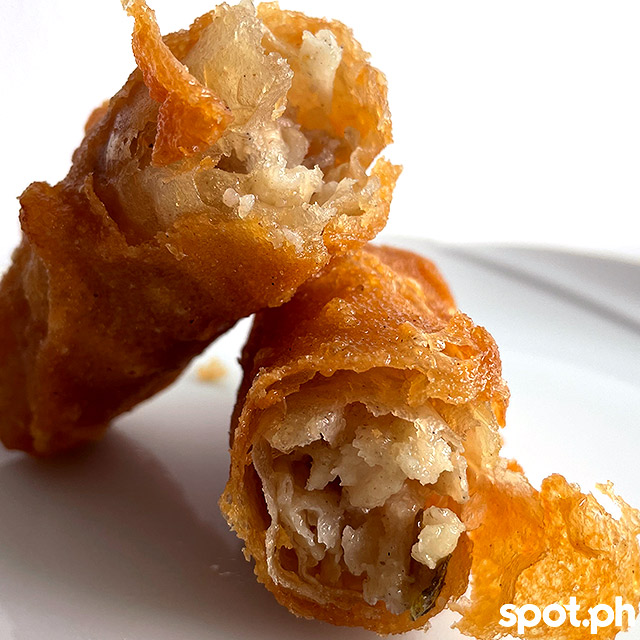
Like its sister brands, the TJRB's ngohiong costs P11 a piece and is 13 centimeters long with a diameter of three centimeters. But TJRB is the one that plays with contrast the most, and it’s what makes it the most pleasant to eat. It might not be the most textbook-standard one, but it’s definitely the funnest to munch on. The filing has a starchiness to it that reminds us of potatoes. The soft (but not mushy!) filling is mildly sweet and is juxtaposed by the saltiness of the crunchy wrapper. It also has a savory quality to it that makes you want to take another bite, and another, then another until you’re sitting there wondering why you consumed all that greasy goodness. It’s this savory aroma that we’re pretty sure is standard in Filipino kitchens, but it’s so cleverly used that it’s become hard to identify.
The play of textures and flavors keeps things interesting enough that you won’t think about needing a dip. Despite that, they have both sauces, and they taste pretty standard. You’re good either way.
Report card: D for not being pin-able on Grab and for not posting any contact info online.
Carlos Special Ngohiong
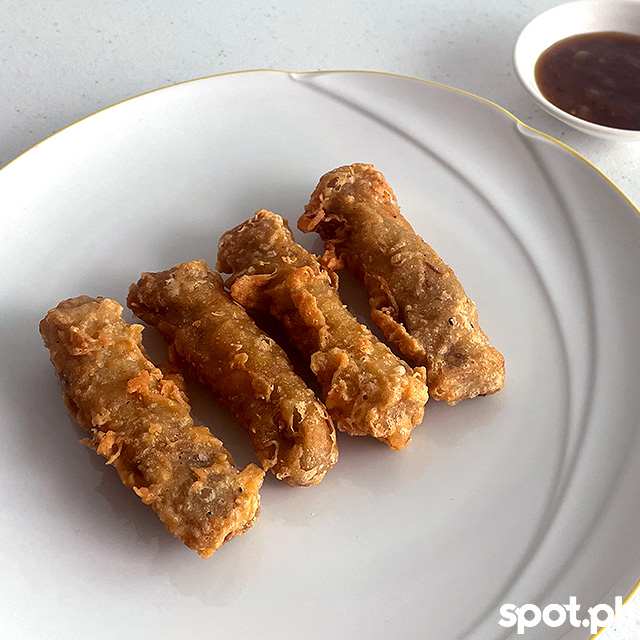
It’s like Carlos Ngohiong just popped up one day and became this sort of cult favorite. It still surprises us how some Cebuanos aren’t familiar with this hole-in-wall chain, if you can call it that. Carlos makes the smallest ngohiong on the list at just nine centimeters, but it has earned the top spot in our books for being the most balanced, which admittedly is hard to detect when eating on its own. But when tasted side-by-side with the rest of the contenders on this list, it shines as the one you can’t say anything bad about.
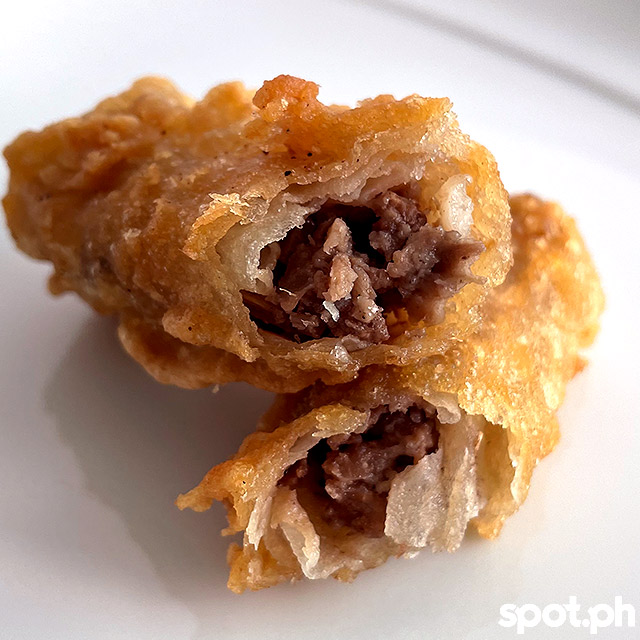
It’s the classic definition of ngohiong—a textural vegetable five-spice roll with that signature crunchy exterior. It is bite-sized and the ubod is crunchy without going into prickly or hairy (think the texture of ginger) territory. The five spice maintains a good balance of flavors despite it leaning toward cinnamon; a flavor that’s somehow complimented by the sweetness that we think can only come from MSG. The only oddity is that chili sauce. Years of eating it and we still don’t know how to describe that flavor. Not necessarily a bad thing.
Report card: A for serving up the classic definition of ngohiong, but we’ll have to give them C– for being hard to find. We feel only a few people even know where the main branch of this gem is located.
Source: Spot PH
No comments:
Post a Comment